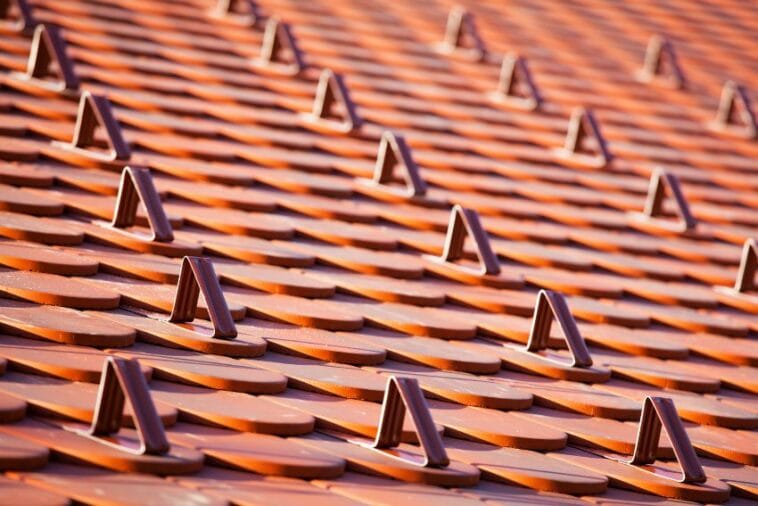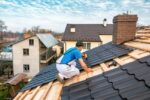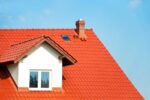This Post may contain Affiliate Links. Please read our Disclosure for legal jargon.
For those living in wintry locales, snow guards are an indispensable component of metal roofs. These essential devices are crucial in preventing snow and ice from falling off metal roofs in large, dangerous chunks. With various types of snow guards available, choosing the right one for your specific metal roof is essential. In this article, we will discuss different types of snow guards for metal roofs, their unique features, and their benefits to help you choose the best snow guard system for your home.
Outline
How snow guards work
Snow guards work by helping snow and ice on rooftops melt completely and drift off the roof in small amounts rather than all at once. By creating friction and providing a physical barrier, they redistribute snow and ice buildup, enabling gradual, controlled melting and minimizing the likelihood of roof avalanches.
Some snow guards primarily work by melting the snow, while others prevent snow accumulation on the roof. Selecting the right snow guard hinges upon several variables, including roof size, pitch, regional climate, and aesthetic preferences. We will look at the different options available, assisting you in making an informed decision.
9 Types of Snow Guards For Metal Roofs
1. Pipe-Style Snow Guards
As the name suggests, Pipe-style snow guards feature horizontal pipes or bars running across the roof. They are both durable and effective, preventing snow from cascading off the roof and providing long-lasting protection.
To maximize efficacy, installing pipe-style snow guards uniformly is crucial to maintaining equidistant spacing between the rows and staggering the pipes. Engaging a professional installer is recommended to ensure optimal results.
Pipe-style snow guards are particularly well-suited for large commercial or industrial buildings with expansive metal roofs. Their robust design can withstand heavy snow loads, making them a reliable choice for regions experiencing substantial snowfall.
2. Snow Brackets: A Versatile Option
Snow brackets come in many styles and materials, ranging from stainless steel to polycarbonate. This versatility enables you to select a snow bracket that seamlessly complements your home’s roof design.
To achieve maximum effectiveness, snow brackets should be installed in a staggered pattern, following the roof’s contours. This ensures even weight distribution and promotes controlled snow shedding.
In addition to their functional role, snow brackets can enhance the aesthetic appeal of your roof. Selecting a bracket-style that harmonizes with your roof’s architecture will create a visually cohesive appearance.
3. Snow Fences: Continuous Barrier Systems
Snow fences are continuous barrier systems extending along the roof’s eave edge, creating a formidable obstacle that prevents snow and ice from sliding off. Constructed from sturdy materials, snow fences provide unparalleled protection against roof avalanches.
Installing snow fences requires precision and expertise. It’s crucial to secure the fence to the roof’s structural members and maintain an appropriate distance from the eave edge. Hiring a professional installer is highly recommended to ensure optimal performance.
To achieve a harmonious appearance, opt for a snow fence that matches the color and material of your roof. This will ensure seamless integration, enhancing the visual appeal of your property.
4. Snow Pads: Friction-Based Snow Retention
Snow pads, also known as snow cleats, are friction-based devices available in various materials, including aluminum, copper, and stainless steel. Increasing the surface friction impedes the movement of snow and ice down the roof.
Proper installation of snow pads is crucial for optimal performance. They should be fastened at regular intervals along the eave edge, following the roof’s contours. Always consult the manufacturer’s guidelines for specific installation instructions.
While snow pads offer effective snow retention, they may not be suitable for all applications. They are best suited for smaller roofs with moderate snow loads. On the other hand, snow pads may be less effective on larger roofs or in regions with heavy snowfall, where other snow guard options may be more suitable.
5. Snow Trappers: Triangular Snow Catchers
Snow trappers are distinguished by their triangular design, which efficiently catches and holds snow and ice. Their low-profile appearance and sturdy construction make them an attractive option for many homeowners.
To maximize the effectiveness of snow trappers, they should be installed along the eave edge, with uniform spacing between each trapper. Ensure that the snow trappers are securely fastened to the roof’s structural members for optimal performance.
Snow trappers are ideal for homeowners seeking an inconspicuous snow retention solution that is both efficient and visually appealing. They are particularly well-suited for roofs with complex geometries or intricate architectural features.
6. Snow Jacks: Adjustable Support
Snow jacks are adjustable, removable snow guards that can be installed or removed as needed. Their flexibility makes them popular for homeowners who want to maintain a clean roof appearance during snow-free months.
To install snow jacks, slide them onto the roof’s standing seam and secure them with the appropriate fasteners. To remove them, reverse the process, and store them safely for future use. Always follow the manufacturer’s guidelines for proper installation and removal.
Snow jacks are best suited for regions with distinct seasonal variations in snowfall. They offer the advantage of removable snow retention, allowing homeowners to adapt their snow management strategy based on changing weather conditions.
7. Snow Clips: Mechanical Barriers
Snow clips are mechanical barriers constructed from stainless steel, aluminum, or polycarbonate materials. They can be color-matched to blend seamlessly with the roof, enhancing the property’s overall aesthetic appeal.
For optimal performance, snow clips should be installed along the eave edge, with uniform spacing between each clip. It’s important to secure the clips to the roof’s structural members, following the manufacturer’s guidelines for installation.
Snow clips are a versatile option suitable for many roofing styles and materials. They are particularly effective on roofs with standing seams, where their low-profile design and mechanical strength make them an attractive choice.
8. Snow Birds: Decorative and Functional
Snowbirds, also known as snow guards, combine form and function, offering a decorative element that also serves as an effective snow retention solution. Available in various designs, they can add a touch of elegance to any roof.
When selecting snowbirds, it’s essential to consider their visual impact on the overall roof design. Choose a style that harmonizes with the architectural features of your home, creating a cohesive appearance that enhances the property’s curb appeal.
While aesthetics are important, it’s crucial not to compromise on the functionality of snowbirds. Ensure that the chosen design provides adequate snow retention to protect your property from roof avalanches and potential damage.
9. Snow Gems: Dome-Shaped Devices
Snow gems are dome-shaped devices that create friction and serve as a physical barrier to impede the downward movement of snow and ice on metal roofs. Their unique design effectively retains snow while maintaining a low profile.
To optimize the performance of snow gems, they should be installed in a staggered pattern across the roof, following its contours. Proper spacing between snow gems ensures even weight distribution and effective snow retention.
Snow gems are available in both polycarbonate and metal materials. Polycarbonate snow gems are lightweight and UV-resistant, making them an excellent choice for regions with intense sunlight. On the other hand, metal snow gems offer increased durability and can withstand heavier snow loads, making them suitable for regions with significant snowfall.
Factors Influencing Snow Guard Choice
1. Roof size and pitch
The size and pitch of your roof are crucial in determining the appropriate snow guard type. Larger roofs or those with steeper pitches may require more robust snow retention solutions, such as snow fences or pipe-style snow guards.
2. Regional climate
The climate of your region also influences snow guard selection. In areas with heavy snowfall, choosing a snow guard capable of withstanding substantial snow loads is essential. In contrast, lighter snow retention solutions may suit regions with moderate snowfall.
3. Aesthetic preferences
Aesthetic preferences should also be considered when selecting snow guards. Some homeowners may prefer a low-profile, inconspicuous option, while others may appreciate the decorative appeal of snowbirds or snow gems.
Importance of selecting the right snow guard type
Selecting the right snow guard type is essential to ensure the safety and protection of your property and the well-being of its occupants and passersby. By carefully considering the various options and their advantages, you can make an informed decision that best suits your needs.
This comprehensive guide is a valuable resource to help you navigate the world of snow guards and make an informed decision for your metal roof.



